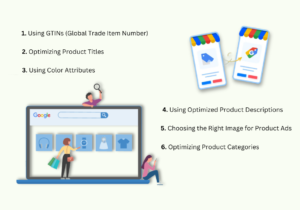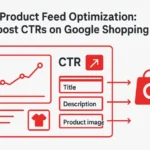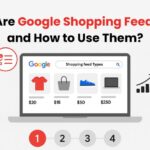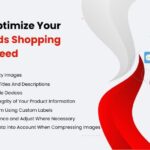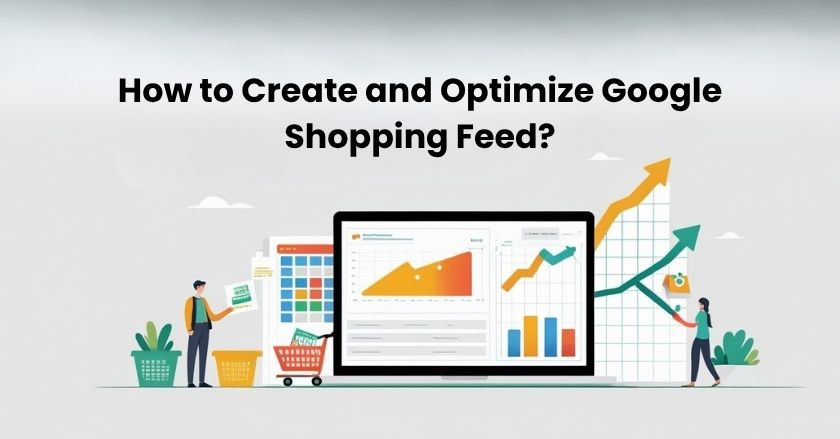
Google Shopping Feed is a file containing significant data about your product catalog. The structure of this file makes it easy for Google to understand. It is used by retailers to upload listings of products from their stock. These lists show the products that are on the market right now.
Ever wondered how retailers display their products on Google? It’s all thanks to Google Shopping. It enables enterprises to showcase their goods in ads and search results.
To begin, retailers need to create a product feed using the Google Merchant Center. This feed must be optimized specifically for Google Shopping to achieve the best results. In addition to improving user experience, proper optimization increases the visibility of your goods.
On the other hand, a poorly optimized feed can cause issues. It might display incorrect product information, fail to reach the right audience, or leave out crucial details. These mistakes can significantly limit the success of your efforts.
In this blog, you will learn the process of creating a Google Shopping data feed. Also, you will learn the proven strategies and essential tips to optimize your product listings effectively. Following this guide, you can improve your visibility and conversions.
Understanding the Google Shopping Feed:
Google Shopping Feeds are crucial files or documents that include information about products you wish to promote on Google. These shopping feeds are important for displaying your items or products in Google Shopping results.
Typically, these feeds contain the product’s title, price, description, captivating image, and stock level. Organizing this data makes it easier for Google to comprehend and present your items.
These feeds frequently feature products along with corresponding campaigns. When users search for specific products on Google, your ads can appear. This increases visibility and connects you with the right customers.
Any business can get a competitive edge with a properly configured and optimized shopping feed. It has altered how consumers find things on the internet. It gives people easy and direct access to the things they are actively looking for.
How Does Google Shopping Feed Work?
It is a powerful tool that connects your products directly to Google’s ecosystem. It serves as an extensive file that holds all of the important details about your goods.
Once the feed is created, it is submitted to the Google Merchant Center. This platform processes the information and ensures it is ready to be displayed to potential buyers. The data in your feed becomes visible to people searching for products similar to yours.
When users type specific keywords related to your products, Google’s system matches those terms with your shopping feed. If there’s a match, your product ads appear in prominent positions on search results. This ensures high visibility, even for shoppers who might not be directly searching for your store but discover your products while browsing Google.
Keeping your shopping feeds updated is crucial for success. Regular updates ensure that product prices, availability, and other details are always accurate. This reduces the risk of errors and builds trust with potential customers.
An error-free shopping feed enhances the user experience. It increases the chances of your products appearing more often and helps deliver smooth, reliable interactions to customers. This ultimately boosts impressions, attracts more shoppers, and improves conversion rates for your business.
How to Create a Google Shopping Feed on Shopify?
Creating shopping data feeds manually is time-consuming and may be difficult. This method suits individuals who prefer managing product listings on their own. It is ideal only for smaller inventories or specific customizations.
However, the best and most efficient way is to use a Shopify app. It’s a highly recommended approach for creating a shopping data feed on Shopify.
One of the best applications for this purpose is the Wixpa Google Shopping Feed. This user-friendly tool can elevate your online presence significantly. With it, you can create multi-product feeds for various advertising platforms and marketplaces.
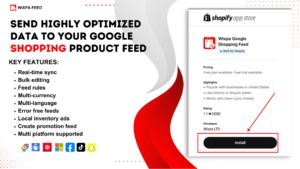
Key Features of the Wixpa Shopping Feed App:
- Built-in feed rules,
- Supports multiple currencies and languages.
- Manages multi-feeds for various platforms.
- Customizes data feeds via meta fields.
- Targets multiple countries.
Steps to Create a Google Shopping Feed on Shopify:
- Log in to your Shopify store:
Begin by signing into your Shopify account.
- Visit the Shopify App Store:
Search for the “Wixpa Google Shopping Feed” app.
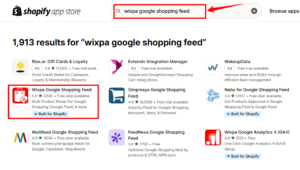
- Install the app:
After finding the app, install it. Then, connect it to your Shopify store.
- Connect with Google Merchant Center:
Link your Shopify store to Google Merchant Center. If you’re unsure how to do this, check out our detailed blog on connecting Shopify with GMC.
- Grant necessary permissions:
Allow all mandatory permissions required by the app. This step is crucial for syncing your feed data seamlessly with Merchant Center.
- Adjust the settings:
Customize the app settings according to your specific preferences and business needs.
- Publish the feed:
Once ready, publish the shopping feed.
- Monitor performance:
Regularly track your feed’s performance. Analyze product data to find areas that need improvement. Make live updates to optimize results and achieve your business goals.
By following these steps and using the Wixpa Shopping Feed app, you can streamline the process and improve your online visibility effortlessly.
Why Should You Optimize Your Shopping Feed?
Your shopping feed needs to be optimized, much like the product pages of your website. Increasing clicks and conversions from potential customers is the aim.
A well-optimized product feed gives more useful information to search engines like Google. This increases the likelihood that your ad will appear more frequently by making your listings stand out and being more relevant to what customers are searching for.
A strong and refined shopping feed is the backbone of your online marketing efforts. It supports all your strategies and helps you stay competitive. Neglecting your feed quality can put you at a disadvantage. Competitors who focus on optimizing their feeds are more likely to outperform you.
By dedicating time and resources to improve your data feed, you can gain a significant edge in the market. Your items and buyers are connected via a refined data feed. This connection makes sure that customers who are actively looking for your products see them.
The benefits are clear. With better relevance, Google will prioritize showing your ads more often. This leads to greater visibility, more clicks, and even reduced advertising costs.
Best Practices for Google Shopping Feed Optimization:
1. Using GTINs (Global Trade Item Number):
Google gives preference to products with a GTIN, and GTIN has grown to be an important component of the optimization process.
GTINs help in assigning a code to every product, ensuring that no two items are alike. Even though they are no longer required, they are still worthwhile.
What is the Role of GTINs in Optimization?
GTINs offer multiple benefits for product optimization.
- Improved Product Visibility
Search engines use GTINs to identify and display products in search results. This unique code increases the chances of your products appearing when users search with related keywords.
- Accurate Product Information
GTINs ensure precise product details, making it easier to manage inventory and streamline delivery processes.
- Higher Priority in Search Results
Google’s algorithm ranks products with GTINs higher than those without them. This boosts visibility and improves the likelihood of customer clicks.
- Better Conversion Rates
Products with GTINs tend to perform better in search rankings. This attracts more buyers and leads to increased sales opportunities.
2. Optimizing Product Titles
Product titles are crucial for success in Google Shopping. Google’s algorithm heavily depends on titles to match user searches. If your product titles lack relevant keywords, they won’t appear in search results, reducing your reach and potential sales.
To optimize product titles:
- Use keywords that your target audience searches for.
- Ensure titles are descriptive and include key details.
- Avoid overly complex language or technical jargon.
- Adding brand names, materials, or features to titles also helps. These details build trust and attract clicks.
3. Using Color Attributes
Color attributes help attract customers who have specific preferences. Providing accurate color details not only enhances customer satisfaction but also ensures compliance in regions where it is mandatory.
Avoid simplifying color names like “pomegranate” to “red.” Google checks your landing page’s microdata to verify product details. Mismatches between feed data and landing pages can harm your rankings.
To optimize color attributes:
- Use accurate names for primary and secondary colors.
- Combine material and color attributes, such as “gold ring” or “silver necklace.”
4. Using Optimized Product Descriptions
A well-written product description is essential for effective marketing. It highlights key features, helps customers make informed decisions, and builds trust.
Elements of an Optimized Product Description:
- Use Relevant Keywords:
Use search-friendly keywords to improve your ranking and attract more visitors.
- Highlight Unique Features:
Showcase what sets your product apart and why it’s a better choice than competitors.
- Use Descriptive Language:
Help buyers visualize the product by using clear and engaging descriptions.
- Organize Data with Bullet Points:
Summarize key features in bullet points for easy readability, especially on mobile devices.
5. Choosing the Right Image for Product Ads
Product Images are the first impression buyers get. High-quality and clear images can significantly increase conversions and clicks.
Tips for Optimizing Product Images:
- Use high-resolution images that accurately represent the product.
- Add alt text with relevant keywords to improve SEO and accessibility.
- Ensure consistency in image style and background across your catalog.
6. Optimizing Product Categories
Product categories are crucial for efficiently arranging your items in the feed. This makes it easier for customers to identify your products when they search on Google by grouping them into unique and easily identifiable categories.
Products that are correctly classified appear in the appropriate search results. This increases visibility and helps your listings match the taxonomy of Google Shopping.
How to Categorize Products:
- Be specific with product types. Use detailed attributes spanning multiple levels of hierarchy.
- Structure categories properly, starting with broad terms and narrowing them down.
- Avoid promotional terms or unrelated content in product categories.
Tips for Product Categorization:
- Understand shopper search intent.
- Focus on specific product traits to refine categories.
- Use data insights to adapt to e-commerce trends and improve performance.
7. Using Custom Labels
Custom labels allow you to segment your products based on business goals like seasonality, sales, or promotions. This improves targeting and strategy.
Tips for Effective Custom Labels:
- Group products by performance, margin, or promotions.
- Use labels for remarketing or personalized ads.
8. Using RegEx in Google Shopping Feeds
Regular Expressions (RegEx) is a tool to clean and organize data efficiently. It helps remove unnecessary marketing terms or standardize product titles in bulk. For instance, RegEx can eliminate “Best Offer” from multiple titles, simplifying your feed.
9. Adding Google Shopping Promotions
Promotions, like discounts or free shipping, attract buyers and encourage quick decisions.
Important Points for Creating Promotions:
- Ensure you have active Google Shopping Ads and Merchant Center accounts.
- Follow Google’s promotion policies to comply with guidelines.
- Schedule promotions in terms of frequency and timing to maximize impact.
By following these best practices, you can effectively optimize your shopping data feed and drive more sales.
Optimizing Google Shopping Feed for Shopify Sellers:
If you are a Shopify seller, optimizing your shopping feeds is crucial. It has a significant impact on how well your shopping campaigns perform. Without proper feed optimization, your campaigns may fall short of their true potential.
Many Shopify sellers encounter common challenges while managing their shopping feeds, such as:
- Ensuring all shopping data feeds have consistent and accurate data.
- Dealing with product disapprovals that lead to delays and frustration.
- Navigating the complexities of shipping and tax configurations.
- Resolving technical issues related to metafields and managing product variations.
- Correcting listing errors or addressing low-performing keywords.
- Struggling with keyword bidding strategies that impact campaign results.
- Facing challenges when expanding to international markets.
These issues can considerably disturb the performance of your Shopify store. However, feed management tools can assist you in overcoming these obstacles. These management tools enhance optimization efforts and simplify the entire process.
One such solution is “Wixpa Google Shopping Feed“, a powerful feed management app tailored for Shopify sellers. This app can handle the complexities of feed management, making your shopping campaigns much easier to manage.
With Wixpa, your journey toward optimized Google Shopping campaigns will be smoother than ever!


